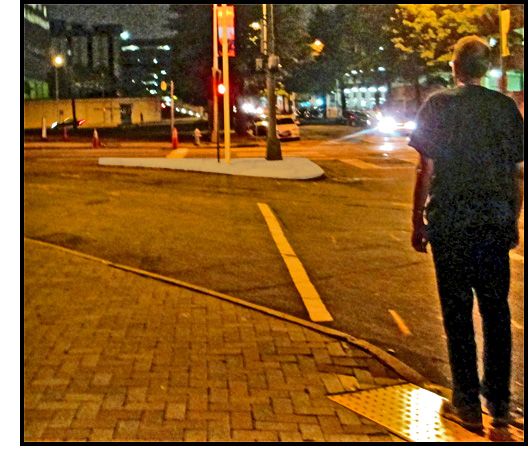
Ideas for Crossing Roundabouts and Channelized Right-Turning Lanes
Compiled by Dona Sauerburger
Compiled by Dona Sauerburger
These ideas were generated by participants during workshops that I did on roundabouts and channelized right-turning lanes for Orientation and Mobility Specialists and Guide Dog Mobility Instructors at SOMA/COMA in Richmond September 29, 2012 and CAOMS in San Diego November 16, 2012.
The workshops included experience with blindfolds at roundabouts and channelized right-turning lanes, and the ideas were generated in the brainstorming afterwards. In the photo to the right, SOMA/COMA workshop participants (L to R) Felisa Massey, Nielah Braylock, and Lauren Madison study their notes at one of the roundabouts.
Understanding features of roundabouts and channelized right-turning lanes
- In order to cross these intersections, it is important to understand their geometry. Links to some information are below
- Features of Roundabouts (including terms such as "splitter islands")
- Channelized Right-Turning Lanes (including terms such as "downstream," "upstream," and "acceleration lanes")
- Channelized right-turning lanes and roundabouts usually have no traffic control, so that means that:
- in order to be confident about whether or not it is clear to cross, the warning times of approaching traffic should be at least as long as your crossing time.
- there are "Situations of Confidence for gap judgment" where the warning time of all approaching vehicles is sufficient,
and "Situations of Uncertainty" where the warning times are not sufficient, so that you never know whether it's clear to cross. - crossings can be Situations of Confidence sometimes, and Situations of Uncertainty at other times.
- you need to be able to recognize Situations of Uncertainty, and Situations of Confidence.
- at Situations of Uncertainty, they need to analyze the risk of crossing, and use alternatives when the risk is not acceptable.
One alternative where there is only one lane to cross and you are in a Situation of Uncertainty with an unacceptable risk is to get the drivers to yield.
-
In order to successfully negotiate these crossings, you have to recognize when you are at a channelized right-turning lane or roundabout.
The following patterns seemed to provide a sound signature that could be helpful for recognizing the crossings.
- When you reach the curb where it starts to turn the corner, traffic passes you and waits in what seems to be the perpendicular street.
- You may hear cars turning right, but there are vehicles waiting on the parallel street beyond them.
- Right-turning vehicles slow down or stop after they pass you.
- You're likely to turn around the "corner"
- The perpendicular traffic sounds far, especially when it's waiting - they seem to wait out in the intersection!
- If you can hear the parallel waiting to your right it seems too far ahead of you.
channelized right-Turning Lanes:
-
The traffic normally waits at the corner and you can hear it near you, but at corners with channelized right-turning lanes, you hear the traffic waiting out in the street, far from you.
So you suspect you're not at the corner, it sounds like you have to enter the street to get to where the traffic is waiting at the corner.
That's when you realize that you have to cross a right-turning lane to get to the corner.
Approaching from the upstream street (street on left)
- Traffic approaching the roundabouts sounded like it was turning right but then it straightened out.
- The traffic traveled in a Y shape (as if separated by something).
That is, traffic approached the roundabout and then veered to the right but the opposite traffic didn't come from the right, it came from the left and then joined the other traffic.
 Aligning
Aligning